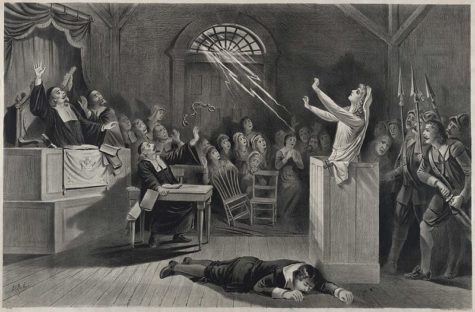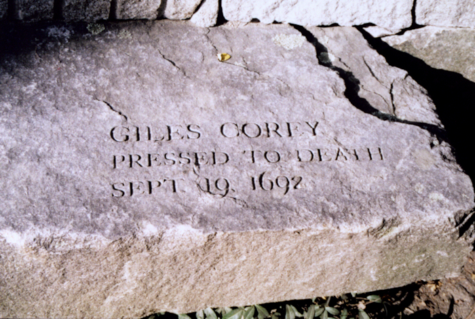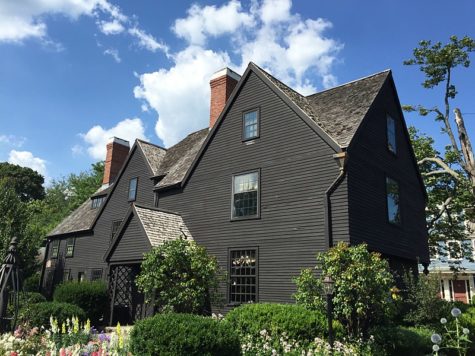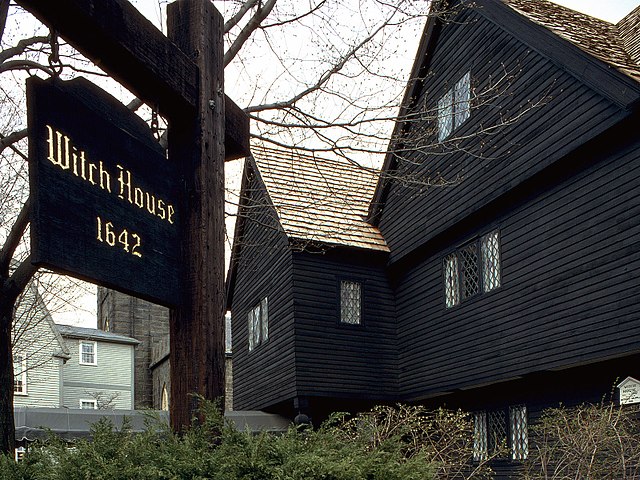The Bewitching History of Salem
America’s infamous Witch City goes all out for the spookiest holiday of the year.
SalemPuritan, CC BY-SA 4.0
Salem, Massachusetts, is home to the biggest Halloween festival in America. Tourists have many opportunities to learn about the town’s sinister history by visiting prominent landmarks and museums while also having a lot of fun within the marketplace and Salem commons.
It’s that time of year again – a return to the crunch of fallen leaves underneath your boots, the smell of freshly baked apple and pumpkin pies, and the cozy feeling of a warm fireplace. But most importantly, it’s time to celebrate the fantastic and spooky holiday of Halloween.
Who doesn’t love to go all out for Halloween? Some might be proud of their neighborhood decorations, awesome costumes, or spooky scary parties, but no one does Halloween like Salem does.
Salem, Massachusetts, nicknamed “Witch City,” is definitely the go-to place for the bona fide Halloween experience. The town has a notorious history dating back to the late 1600s, pre-dating even the American Revolution.
The grave reputation of Salem hinges upon the Salem Witch trials, and as such the town’s Halloween festivities center around the incident. One thing is for sure: Salem doesn’t forget.
The Trials – Witch Craze of Massachusetts
A witch trial, notably prevalent in Middle-Age Europe, is an investigation carried through court to uncover those guilty of witchcraft and consorting with the devil. The Salem Witch trials are the most famous witch investigations in history, occurring in colonial Massachusetts during 1692-1693. The trials launched the colony into a witch hunt craze that climaxed with 300 women accused of witchcraft, and 30 of them executed for it. Due to this haunted episode of endless accusations, court trials, and numerous executions, the Witch hunt of Salem bestowed a spooky reputation for Massachusetts for generations to come.
The events began when Elizabeth Parris and her cousin, Abigail Williams, started to experience sudden abnormal occurrences. They screamed randomly, uttered peculiar noises, and contorted themselves into freakish positions. Salem society could not explain this eerie phenomenon; they started to fear the worst, that the Devil had come to their small town.

The afflicted girls blamed three women for their unusual state: an enslaved Caribbean named Tituba, a beggar named Sarah Osborn, and a poor, elderly woman named Sarah Good. Their claims were supported due to Thomas Putnam’s and Samuel Parris’ high status in Puritan society. (The two men were related to the affected young girls.)
The three accused women were taken into custody to explain themselves. Osborne and Good claimed they were innocent during their trial. Tituba, the Parris’ slave, said, “The Devil came to me and bid me serve him.” All three women were found guilty, however, and imprisoned. They all died inside their prisons before they could be tried.
Not long after their imprisonment, paranoia swept across Salem. The settlers all started to fear that the Devil had indeed arrived in their town. Many more instances of alleged witchcraft started to rise. Accusation after accusation left hundreds of women in jail, and eventually, in June of 1692, Bridget Bishop became the first woman hanged during the span of the trials.
The judges of the trials did not limit their cruelty to just hanging people who were powerless in Puritan society. Giles Corey, an English farmer in the town, was accused of witchcraft along with his wife. He was pressed to death by a large stone after he was found guilty. Rebecca Nurse, a well-respected community member and a mother of many children, was found guilty and hanged as well.


How did the trials take a dark turn? Historians today cannot find a definitive reason as to why the trials spurred out of control. They speculated that there was more to it than meets the eye.
Kathy Wilson, a historian specializing in 18th and 19th century British-American history, explains that there might have been religious paranoia, as well as greed, that led to the accusation of women.
“They had no problems pointing fingers at other Anglicans and Catholics and charging them with witchcraft if they felt at all persecuted or threatened by these individuals,” Wilson said. She also explains, “there was an agenda in gaining control of the land in the village.” This means that if a person accuses someone else of witchcraft and the accused is found guilty, the accuser gains their property.
Others say it was an event that symbolizes society’s disdain for women. According to journalist Heather Greene, the trials were “a weapon thrown at women.”
It’s not that difficult to make a connection to how colonial Massachusetts became corrupted with murder and paranoia with society’s view on women in general. Greene explains that witchcraft was “not only a derogatory label that’s associated with women, it’s also a term that’s been used to define the ‘evil aspects’ of femininity.”
The Salem Witch trials left a defining mark in American history. The Puritans and their religious beliefs caused a massive spur, ultimately ruining multiple lives. According to TeenVogue, “In the wake of their own persecution, this God-fearing, patriarchal society was determined to preserve its way of life and belief system at any cost.” The utter despair and paranoia the Puritans of Massachusetts faced imprinted a message for everyone to learn: fear can quite literally kill.
Haunted Happenings – What to do?
Salem celebrates the holiday of Halloween all month long; where a variety of events and activities are open to the public to get their spooky-season started. Want an exclusive tour inside the Witch Hunt museum? Taking a stroll through the haunted Gallows Hill Park? Or maybe you’re in the mood for a classic haunted house with friends. Salem has it all during Haunted Happenings!
The town’s most popular events during the festival season have to be the exclusive tours inside the historical museums, The Salem Witch Museum among its most popular. The museum is split into two exhibits — a play and an informational presentation. The play showcases the dark and dramatic past of the Salem trials on the stage with extraordinary use of narration and lighting. The second exhibit is more informative, covering the origins of the word “witch,” and providing the history of witch hunts in Europe before the events occurred in Massachusetts.
The Witch Dungeon Museum similarly displays what happened in Salem with an elaborate show. The audience is welcome to enjoy a live witch trial with dummies and actors. You can travel back in time and learn more about the trials inside the dingy courts of the so-called “innocent” Puritans.

(Fletcher, CC BY 4.0 <https://creativecommons.org/licenses/by/4.0>, via Wikimedia Commons )
Visitors can also see many historic buildings tied to individuals featured in the trials. The Rebecca Nurse Homestead belonged to the great-grandson of Rebecca Nurse. The house was purchased from family to family until 1907, when the Rebecca Nurse Memorial Association renovated it. This museum not only honors the woman who was hung over false accusations, but also stands to emphasize the development of Massachusetts over the course of three hundred years.
Visitors may also view the house of Jonathan Corwin. He was one of the judges during the trials. He lived a long life, and passed away in 1718, not once showing any remorse or guilt for his actions in 1692. His home, built circa 1675, is now known as the Witch House, and is the only remaining structure that has a direct connection to the witch trials.
Salem has many other activities for people to enjoy that do not center around the witch trials. For example, the murder and mysteries nighttime walking tour allows travelers to listen to gory murders, as well as multiple ghost sightings. Not only is this a way to elevate your heart rate, it is also a way to explore the town of Salem during its eeriest hours.

Salem is also home to New England’s oldest wooden mansion. The House of Seven Gables, built in 1668, was the home of a merchant John Turner I and his wife Elizabeth Robinson Turner. This house became a national historical landmark in 2007 and is a must-visit place for literature fanatics. The mansion is the main setting in Nathaniel Hawthorne’s renowned gothic novel, which also symbolizes corruption, sin, evil, and injustice of the past. Ironically, it foreshadows the trials that took place later during the late 1600s.
Finally, visitors can explore the Haunted Happenings’ Marketplace for some traditional fun! There are many vendors, street performances, and photo stations to keep everyone busy. Multiple restaurants and street food vendors are also available.
Salem is certainly a unique place to visit. For a town with such a dark history, it’s Halloween festivities never fail to thrill tourists. Next time you think about celebrating Halloween, consider traveling to “Witch City” to take part in a bewitching experience.
Salem is certainly a unique place to visit. For a town with such a dark history, it’s Halloween festivities never fail to thrill tourists. Next time you think about celebrating Halloween, consider traveling to “Witch City” to take part in a bewitching experience.
Maliha Chowdhury is an Editor-in-Chief and a Social Media Editor for ‘The Science Survey,’ and she enjoys the value of truth that is expressed in journalistic...

